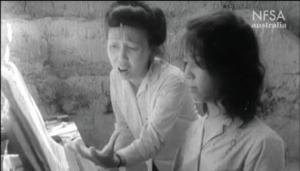Apr 04 2018
The Story of the Vietnamese Symphony
The documentary Vietnam Symphony is about the Hanoi Conservatory of Music (now called the Vietnam National Academy of Music) during the Vietnam War. When the first bombing raid by the US occurred, the Vietnamese Government moved all of the schools in the country from the cities to the countryside where they were less susceptible to bombings. The conservatory was relocated to a small village called Xung Phu where students and teachers had to leave their family and friends for the duration of the war. They brought their own instruments, bringing larger instruments like pianos via trucks and trains, the teachers and students of the conservatory had to do all the moving. Along with this, they dug an underground campus with pathways between classrooms so they could stay underground at all times away from possible bombings. These efforts show how dedicated they were to continue to teach and learn music despite the war. The group lessons were taught in the underground classrooms but individual lessons were often taught above ground in villager’s houses because there was enough space to do so. The conservatory only had one piano for all of its students so it was used 24 hours per day every day and students would take shifts practicing. The generation of Vietnamese musicians that came from this era of the school is known for having extreme passion in their singing and musical play due to having to be relocated and fearing for their lives during the war.

Here is a picture of an instructor teaching piano to one of her students on the one underground piano
At first, it was weird between the villagers and the musicians from the city because they had lived such different lifestyles up to that point. The villagers were farmers who lived simple countryside lives while the musicians came from more advanced cities. However, as time went on the villagers and musicians learned to live together well and even became friends helping each other out. The students would often put on shows for the villagers to thank them for their hospitality which provided a way for the villagers to get their minds off the war for an hour or so. The conservatory members also helped harvest crops when the villagers had a labor shortage which allowed for the students to get a taste of life in the country and reminded them to keep studying!
Along with performing for the villagers, the students often performed for soldiers during the war. They would be picked up and brought to army bases where they would sing, dance or play an instrument for soldiers to provide them with entertainment. One of the interviewees from the documentary said that they used the power of music to distract the soldiers from the war because of the sound of a bomb was nothing compared to the sound of music.
Here is a picture of a young student playing an instrument for soldiers. He is sitting on a rocket and using it as his stage.
Eventually, the war came to a close and the conservatory was able to move back to Hanoi. The school was sad to leave the village as they had made so many friends over the long war period, but as they arrived home they were ecstatic to be back and to finally continue life as normal. However when they returned they found their school was used as a factory to produce weapons and vehicles for the war. Of course, nothing came easy to these young music prodigies and they had to clean and restore their school before using it again.
While this story took place in Vietnam, it does relate to the Southeast Asia region as a whole. During the time of the Vietnam war, a lot of the countries in the region had their own struggle of capitalism vs. communism which changed the lives of people in those countries just as much as it did for students in Vietnam. The story also relates to one of the main themes we have talked about a class where Western countries do as they please at the extent of less developed countries. The United States went into Vietnam for their own personal interests and completely changed the landscape of the country forever. This is similar to when Europan Countries decided to split Africa among themselves and when the U.S., Russia, and other countries got involved in the Middle East. Another interesting way the story relates to our class is with physical geography and how we often talk about how different physical landscapes allow people to live in certain ways. The village of Xung Phu was known for being a relatively dry area with lots of dirt. This allowed for the teachers and students of the conservatory to dig the underground campus which they would not have been able to do if the village was located in a swamp or other wet landscape.
Overall I would recommend the documentary to anybody who is interested in music or war and how it affects people. It has an interesting combination of black and white footage from the time period and interviews with people from the village and former students and teachers from the conservatory.
Give it a watch here!
https://elon.kanopy.com/video/vietnam-symphony
References:
“Vietnam Symphony.” Welcome to Elon University | Kanopy, National Film and Sound Archive of Australia, elon.kanopy.com/video/vietnam-symphony.
*Everything I used came from the movie including pictures which are screenshots
